
| Maritime Topics On Stamps :
|
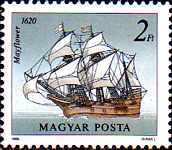
| |
The Pilgrim-Fathers’ Voyage with the 'Mayflower'
|
|
In 1620 a group of religiously separatists chartered a ship called
'Mayflower'.
Around that time, there were supposedly four different ships with this same
name, so we do not know exactly which one it was that sailed to America.
|
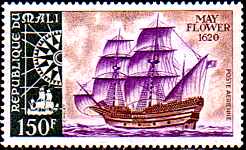
|

| |
It is said that the 'Mayflower' fought against the Spanish Armada in 1588.
From this we may assume that she had similar measurements and appearance of a
galleon.
A three-masted ship with a high platform aft, of approx. 180 tons, length
of 90', beam 24', depth 13', armed with 10 cannons (in 1588), crew of 40.
It is not known whether there were three square sails set on foremast and main
mast (as shown on the Mali stamp) or just two.
The 'Mayflower' was employed bringing wine from the Mediterranean to England
and outward bound she carried furs and bales of cloth to France.
|
|
The Pilgrim Fathers were a small group of English Puritans who had separated
from the Anglican Church. After fleeing to the Netherlands, in 1607/08,
seeking refuge from persecution in England, they decided to pursue greater religious
freedom in Colonial America.
|
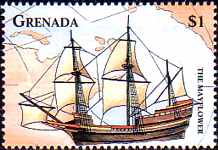
| |
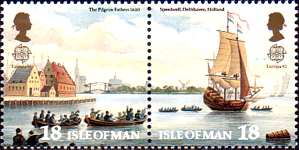
|
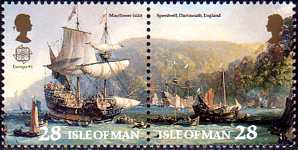
|
They made a contract with English merchants who chartered
two ships for the pilgrims and financed the journey. In return,
the emigrants were to send back cargoes of fish, furs and lumber.
On July 22, 1620, the emigrants boarded the 60 ton ship 'Speedwell'
(left stamp) in the Dutch port Delftshaven and sailed to Southampton.
There they changed over to the larger 'Mayflower', and both ships were
intended to
sail to America together. Both ships left port on August 5, 1620. Shortly
after departure the 'Speedwell' was found to be leaking and both ships
returned to Dartmouth (right stamp).
After two weeks of repairs, they
started out once more. But the 'Speedwell' still was leaking and both ships returned
once more, this
time to Plymouth. There, the 'Speedwell's provisions and goods were loaded
onto the
'Mayflower'; the 'Speedwell' was given up and stayed behind.
|
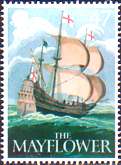
|
On September 16 the ' Mayflower ' left Plymouth with 101 passengers, 31
children among them.
The crew consisted of 34 men, captain was Christopher Jones.
As this was the time of autumn storms, there was on board a full inventory of
sails for easy, medium, and heavy weather.
Inside the cargo hold there was a 30 feet long launch intended for future
reconnaissance trips. The cargo hold chock-full with all kinds of goods served
also as accommodations for the passengers at night and during heavy weather.
Overhead space was so low that an adult was unable to stand up.
|
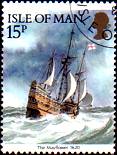
|
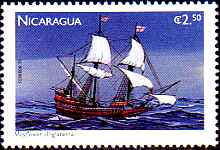
| |
Daytimes during good weather conditions the passengers could stay on the
main deck.
There they could cook on small coal pans placed into sand boxes. But the
'Mayflower' encountered several heavy storms during which the passengers
were brutally tossed about and kept below decks for lengthy periods of time.
It stank terribly of excrements and the vomit of seasick humans. At one time
a deck beam broke amidships. It was screwed together again and strengthened
with additional wood. But uncertainty and fear spread. A passenger and a sailor
died of diseases. A child was born and was baptized 'Oceanus'.
|
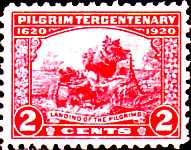
|
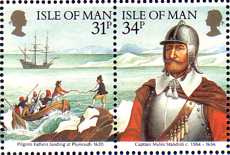
| |
On the 9th of November they sighted land. On November 11 the 'Mayflower'
anchored off today's Provincetown in the Bay of Cape Cod. The Pilgrim
Fathers fell to
their knees and thanked their God. But the shore was barren, it was cold and
snow began to fall. They encountered Indians who were decidedly unfriendly.
Led by Captain Miles Standish (right stamp), several reconnaissance forays
were accomplished with the
launch. Eventually, they found a place with fresh water brooks and land
suitable to cultivate grain. On December15 the 'Mayflower' sailed to this place,
which at that time already was called Plymouth.
|
|
Throughout the winter the passengers remained on board the 'Mayflower'. Here
they suffered an outbreak of a contagious disease which has been described as
a mixture of scurvy, pneumonia and tuberculosis. When it was over, there were
only 53 persons still alive, half of the Pilgrims and half of the crew.
Nevertheless in spring they built huts ashore and on March 21,1621, the surviving
passengers left the 'Mayflower'.
|

|
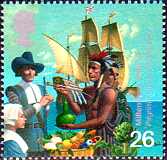
|
The ship was now supposed to return to England with cargo, but there was
nothing the
Pilgrim Fathers could have provided. So, on April 5 Captain Jones sailed
back to
England with an empty ship.
The Pilgrims began to sow their grain and built themselves sturdier houses.
They met a helpful, English-speaking Indian called Squanto. He taught
them how to catch fish in the rivers and helped them with the cultivation of
corn,
with seeds he brought along by himself.
In the fall the harvest was brought in. Squanto's native grain showed far better
yields than the grains brought over from Europe. They celebrated a
three-day-long harvest festival with additional friendly Indians.
|
|
On November 11, 1621, the ship 'Fortune' arrived at the colony with
additional 35 settlers. There also was a letter of complaint from the ‘Mayflower’s
financial backers regarding that ship’s return voyage without any cargo. The
Pilgrim Fathers loaded the
'Fortune' with beaver furs and lumber and sent her back. But she had the bad
fortune to get taken by a French man-of-war.
|
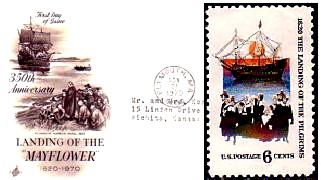
|
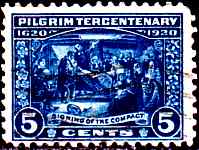
|
While still aboard the ‘Mayflower’, on November 21, 1620, the Pilgrims’ 41
adult male passengers had signed the 'Mayflower Compact' (see left stamp
'signing of the compact'), an agreement that bound the signers to majority rule
government in the Pilgrim colony, pending receipt of a royal charter. The
document represents a significant step in the development of democracy in America.
|
|
The journey of the Pilgrim Fathers was the prelude to ever increasing
transatlantic immigration. 1630 saw the arrival of a fleet of 17 ships carrying
Puritans to the 'New World'. And for the following 250 years, sailing ships acting
as 'covered wagons of the Atlantic' undertook the largest migration of peoples
in history. By the end of the 19th century approximately eleven million human
beings had followed the Pilgrims across the Atlantic.
The block at right shows their American settlement called the Plymouth Colony.
|
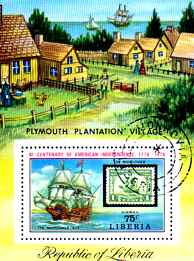
|
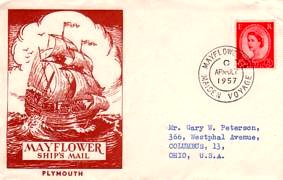
|
During 1955-56, a replica of the ‘Mayflower’ was built at Brixham, U.K.
Designed by naval historian W.A. Baker, her specs are: hull length 105 ft, beam 25
ft, depth 12 ft, displacement 365 tons, six sails with 470 square meters surface area.
In 1957, commanded by maritime author Captain Alan Villiers,
'Mayflower II' arrived at the Pilgrim Fathers’ Plymouth after an Atlantic crossing of
53 days (see cover). Following some short cruises along the U.S. East Coast,
'Mayflower II' found her final berth serving as a museum ship at Plymouth,
Massachusetts.
|
|